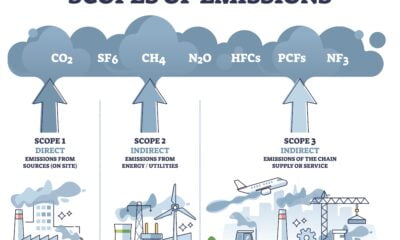

Energy
Aviation Sector Must Join Forces to Combat Emissions
A three-day meeting of the International Civil Aviation Organization (ICAO) was held this month. The meeting concluded with a warning that nations must work together to limit emissions in the aviation sector. Currently there is a clear divide over how to share the advantages and disadvantages of pollution cuts in the sector.
Top officials were in attendance at the ICAO meeting from 11-13 May, where prominent environmental groups advocating for a “Flightpath to 1.5 degrees” warned that ICAO risked a high profile failure at its September assembly of delegations if it didn’t find ways to bridge key differences quickly.
At the meeting, held at ICAO’s Montreal headquarters, countries attempted to move forward a draft proposal for a global market based measure to limit net carbon dioxide emissions from international aviation to 2020 levels. The text will be taken up again at the June meeting of the ICAO Council, a governing body that includes key countries like the US, China, the UK, South Africa and Brazil. The environmental organizations that make up the campaign Flightpath 1.5 say the current version falls short of what is needed to meet ICAO’s own targets and the long-term temperature goals laid out in the Paris Agreement namely to limit the increase in global temperatures to 1.5°C above pre-industrial levels.
In an apparent effort to bridge the divide between China and countries such as the US, Japan, Chile, and EU states, Singapore proposed a “pre-implementation phase” of the market-based measure. Many countries indicated their interest and desire to understand what such a phase would entail, but environmental observers of ICAO believes it’s risky. It must be designed to ensure that ICAO meets its 2020 emission goal, not delay effective action on aviation emissions.
In addition to the new concept of a pre-implementation phase, ICAO’s High-level Meeting last week yielded progress in some areas while delaying decision on or worsening other parts of the draft text being negotiated.
Solid progress was made in two areas:
Offset criteria: Countries intend for the offset criteria to be reflected by ICAO as standards, whereas before it appeared they would only be established as guidance. This is something Flightpath 1.5 NGOs have advocated for the past several months.
Reviewing the MBM and aligning it with the Paris Agreement: The review clause in the text of the market-based measure has greater detail and now explicitly calls for consideration of the necessary improvements to have the aviation industry contribute its fair share towards the long-term temperature goals in the Paris Agreement.
But some issues remain unresolved:
Emissions covered under the MBM: On the question of who will be covered by the program, delegates took a big step backward. Going into the talks, they considered a formula that would have exempted countries representing 33 per cent to 40 per cent of the program’s offset requirements in the first five years. By week’s end they exempted even more, representing around 50 per cent of all aviation emissions from the same period. As the negotiations continue over the coming months, delegates must search for a way to make up to this gap if ICAO is to meet their own 2020 emissions goal.
Differentiation of airline offsetting obligations: At the meeting delegates ultimately sidestepped the crunch issue of how to divide up emissions cutting responsibilities, with deep divisions remaining between slow growing and fast growing aviation states. There have been multiple references to exploring how to increase the coverage of international aviation emissions and thus increase the environmental integrity of the MBM.
The draft text of the MBM that countries are negotiating will be updated and forwarded for further negotiations in June. At the council meeting and in bilateral discussions, countries must work together to explore how to come to an agreement on crunch issues like differentiation and how to make up the current emissions gap, so ICAO is able to meet their own 2020 emissions target.
ICAO’s 191 Member States have spent 19 years wrangling over the issue of how to address international aviation pollution. In 2013, they gave themselves a deadline of October 2016 to finalize the global MBM. Unless action is taken, aviation’s climate pollution is forecast to triple in coming decades.


 Environment10 months ago
Environment10 months agoAre Polymer Banknotes: an Eco-Friendly Trend or a Groundswell?

 Environment11 months ago
Environment11 months agoEco-Friendly Home Improvements: Top 7 Upgrades for 2025

 Features9 months ago
Features9 months agoEco-Friendly Cryptocurrencies: Sustainable Investment Choices

 Features10 months ago
Features10 months agoEco-Friendly Crypto Traders Must Find the Right Exchange






























